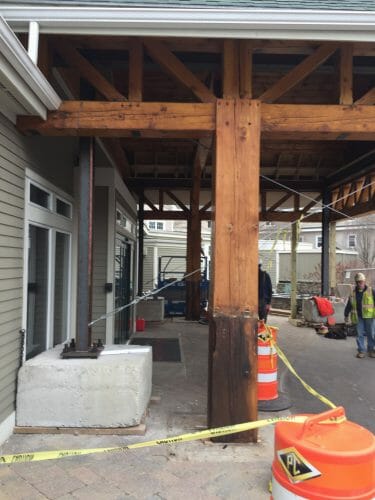How Do you Protect Timber and Joints Exposed to Weather?
How do you protect the timbers and joints where they are exposed to the weather? I noticed that exposed beams are common at the entryways to many homes.
Thank you
Hi Richard, thank you for your question.
There are a couple factors that aid in the lifespan of exterior timbers. The first item is usually timber species. Certain species, like cedar, have natural oils present in the timber that aids them in resisting rot and effects due to the aging process. Only oak pegs should be used if there are traditional joinery elements – birch pegs (VTW’s choice for interior structures) often rot much faster than oak pegs.
The most important aspect with exposed timber is to make sure it is exposed to air, so that it can dry if it gets wet. This is why exterior posts (and almost all interior posts) have a standoff to prevent the bottom from sitting on grade/concrete/in standing water and remaining wet. For the same reason, this is why timber posts should not be surrounded with masonry pier, but rather sit on top with a moisture break between the timber and masonry (i.e. galvanized plate). As long as a timber can dry fully following a rain, it should have a long lifespan. If you are interested in a visual of what a lack of air can do to a timber, check out our article of Rot in Heavy Timber Columns here.
An exterior rated stain/polyurethane/sealant is also a key component – they help to protect the timber and can also enhance the look significantly over time. Occasionally a client wishes to have an exposed timber look (grayed and aged appearance), and that can be achieved with no stain and simply leaving the timbers to dry naturally. But if a certain appearance is desired, the stain/seal/etc. should be reapplied every ~5 years or so, depending on conditions.
Lastly, end-gable trusses are often exposed to water from rain, even with a significant overhang. In these cases, all mortises should have a 3/8” weep hole drilled vertically down through the timber from their lowest part – this prevents water from accumulating in the mortise pockets, where standing water could rot the tenon, mortise, and/or peg resulting in a lack of structural integrity.
Hope this helps!
Sincerely,
Matthew McGinnis, EIT
Junior Timber Frame Engineer
Vermont Timber Works


the drain hole you talk about I understand in a blind mortise there the post meets the floor but what about where the cross beam meets the post nearly 18″ below plate , should I put a drain hole in there as well? or would you suggest using a different method of tying the cross beam where It meets the plate I read about species and sealer, would linseed oil be a good choice
Hi Ian,
Linseed oil is not the best choice. It tends to mold and discolor over time. Total Wood Preservative or Benjamin Moore Arbor Coat are much better. All surfaces, including mortise pockets and tenons, should be sealed. Weep holes should be added to avoid water pooling in the joints. Weep holes are not required where water can drain out of a joint naturally.
Thanks,
Caitlin
we have a small bridge that needs to be resealed, and everyone i’ve talked with, tell to go to Nevada to purchase sealant, because here in California they can’t sell the stuff that actually works, because of environmental regulations. any suggestions on which brand to use. i’m wondering if the Benjamin Moore product you mentioned, if they formulate it differently for the California market. thanks
We are located in Vermont, which I believe has similar environmental regulations. We’ve used Benjamin Moore Arborcoat in the past, but it needs to be reapplied about every 5 years. You’ll have to see if that’s available for use in California and if that’s the product you’re thinking about.
Thanks,
Caitlin